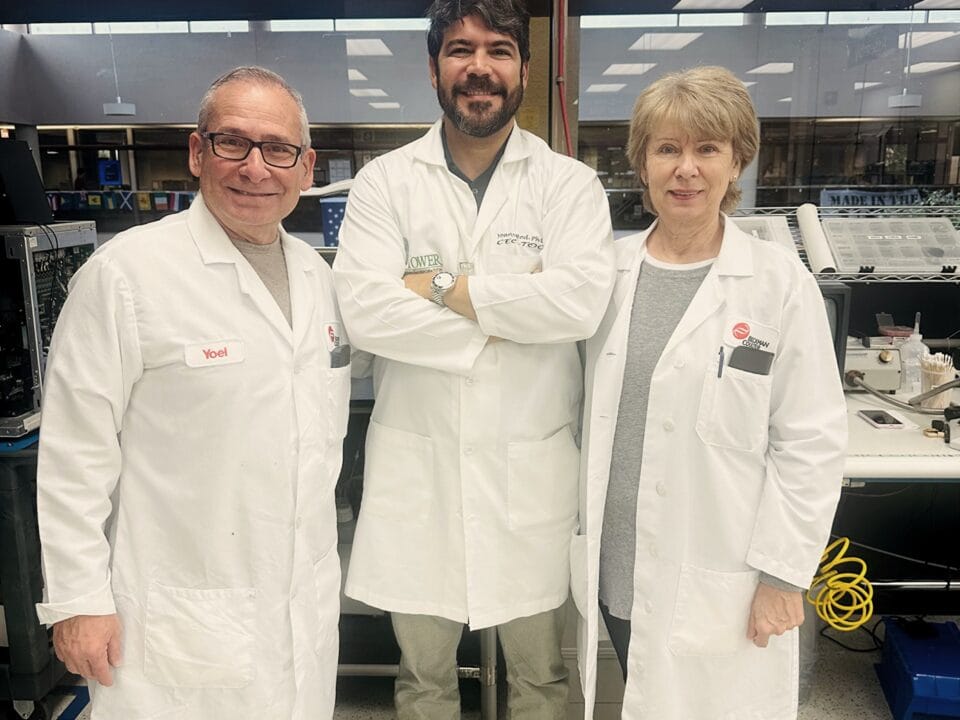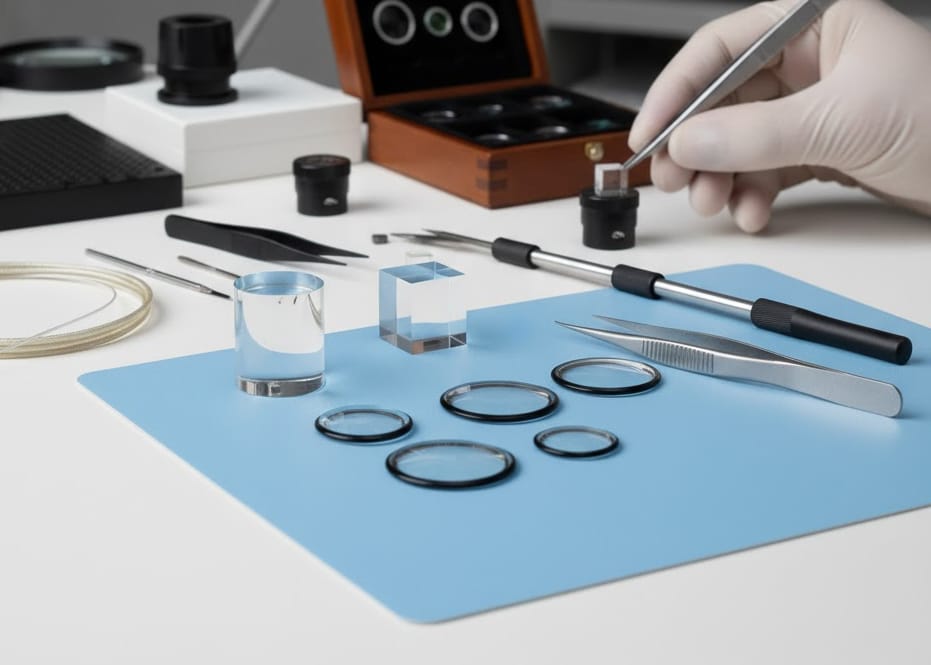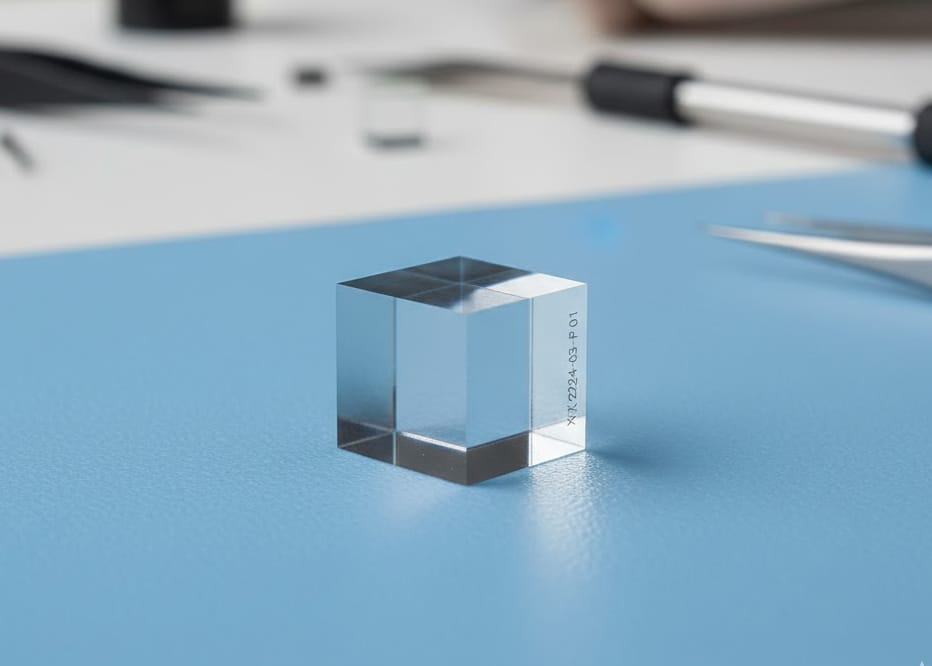
The Ultimate Guide to Precision Optical Components
Sunday, 26 October, 2025
Tower Optical Expands into Life Science Applications with Beckman Coulter Collaboration
Monday, 10 November, 2025Did you know that a flaw smaller than a speck of dust can ruin the performance of advanced optical equipment? I am referring to micro prisms, and specifically, the quality of their surfaces. The term micro prism surface quality may sound technical, but it is crucial. It dictates the performance of everything from smartphone screens to complex medical devices. These minuscule components punch far above their weight in optical systems, and even minor surface defects spell disaster.
Throughout my years in this field, I have seen how tricky it can be to get these tiny marvels to perform as expected. Scratches invisible to the unaided eye can scatter light, dim images and undermine the entire system. It is not an overstatement to emphasize how vital surface quality is.
Think of microprisms as shrunken versions of regular prisms, often just micrometers across. Do not let their size fool you; they have a wide array of uses:
- Displays: Boosting brightness and expanding viewing angles in LCDs and similar technologies.
- Imaging Systems: Fixing distortions and sharpening images in microscopes, cameras and telescopes.
- Optical Sensors: Enabling accurate light sensing and measurement in medicine and environmental science.
- Biophotonics: Manipulating light at the cell level, enabling advanced microscopy, flow cytometry and other essential biomedical work.
A microprism works by reflecting and bending light with phenomenal accuracy. Its surface condition is fundamental to its effectiveness. Any flaw, however small whether roughness, a scratch or some contamination will scatter and diffract light in unintended directions, altering the light path and reducing performance.
The Impact of Surface Quality on Optical Characteristics
Micro prism surface quality directly shapes critical optical characteristics:
- Transmission: A dirty or uneven surface scatters light, decreasing the amount of light passing through. This is especially noticeable when light levels are low.
- Image Contrast: Scattered light reduces contrast, blurring fine details. The result is blurry or washed out images.
- Beam Uniformity: Flaws distort the light beam, causing uneven lighting, a problem when uniform and precise light distribution is required.
- Resolution: Surface defects blur and distort images, reducing resolution.
I recall working on a tiny endoscope for medical use. The initial prototypes gave poor images. A thorough investigation traced the problem back to the prism surfaces. Despite being the correct size, they were too rough, causing excessive scattering. We achieved the needed image clarity only by implementing stricter polishing.
Understanding Surface Roughness
Surface roughness is a crucial factor, describing microscopic surface irregularities. Several statistical measures quantify these irregularities. Some examples include:
- Ra (Arithmetic Mean Roughness): The average absolute deviation of the surface profile from the mean line, giving a general indication of roughness.
- Rq (Root Mean Square Roughness): The root mean square average of the surface profile deviations from the mean line, more sensitive to peaks and valleys than Ra.
- Rz (Maximum Height of the Profile): The vertical distance between the highest peak and the lowest valley within a given sampling length, indicating extreme variations in surface height.
These measures are often taken using these methods:
- Atomic Force Microscopy (AFM): A high resolution technique using a sharp tip to scan the surface and measure its topography at the nanometer scale. We have used AFM extensively in our lab to determine microprism surface roughness.
- Optical Profilometry: A non contact method using light interference to measure the surface profile. It is faster than AFM but usually has lower resolution.
- Scanning Electron Microscopy (SEM): Giving high resolution surface images, allowing visual inspection of irregularities and defects.
Acceptable roughness depends on the prism application. High precision optical systems need minimal roughness, sometimes down to the nanometer range or even less.
Optical Scattering and Surface Quality
Optical scattering happens when light deviates from its intended path due to inconsistencies in the material or surface flaws. Regarding micro prism surface quality, scattering is primarily due to surface roughness. Light striking a rough surface reflects or bends in many directions, instead of following a single path.
The extent of scattering depends on these factors:
- Surface Roughness: More roughness causes more scattering.
- Wavelength of Light: Shorter wavelengths scatter more than longer wavelengths. This is why blue light scatters more than red light in the atmosphere, making the sky look blue.
- Angle of Incidence: The angle at which light strikes the surface affects scattering.
- Material Properties: The refractive index and absorption coefficient affect scattering.
Scattering falls into two types:
- Specular Scattering: Light reflects or bends in a single direction the desired behavior.
- Diffuse Scattering: Light scatters in multiple directions the unwanted scattering that hurts optical performance.
The goal in making great microprisms is to minimize diffuse scattering while maximizing specular refraction/reflection. This requires careful manufacturing to create a smooth surface.
Manufacturing and Polishing Techniques
Excellent micro prism surface quality demands advanced manufacturing. There are several options, each with pros and cons:
- Precision Grinding and Polishing: Established methods remove material from the surface using abrasives. These can produce very high surface quality but are expensive and take time. We have improved these by carefully adjusting polishing pressure, speed and abrasive particle size.
- Micromachining: Techniques such as diamond turning and focused ion beam milling can make microprisms with phenomenal precision. These are usually limited to certain materials and geometries.
- Replication Techniques: Methods like hot embossing and injection molding can copy microprisms from a master mold. These are cost effective for mass production but may not achieve the surface quality of direct machining.
- Etching: Chemical or plasma etching can create microstructures on a substrate, making microprisms with complex shapes.
Whatever the method, controlling process parameters to achieve the needed surface quality is key. This includes pressure, temperature, processing time and chemical concentrations.
Polishing is crucial for achieving the required surface quality. Fine abrasive particles remove material, reducing roughness. The correct polishing method depends on the material, desired surface quality and production volume.
Typical polishing techniques include:
- Mechanical Polishing: Using a polishing pad and abrasive slurry to remove material. The pad material, polishing pressure and abrasive particle size are critical.
- Chemical Mechanical Polishing (CMP): Combining mechanical polishing with chemical etching. CMP is common in the semiconductor industry for planarizing silicon wafers.
- Magnetorheological Finishing (MRF): Using a magnetorheological fluid containing abrasive particles. It is capable of very high surface quality and well suited for polishing complex shapes.
- Ion Beam Polishing (IBP): Using a focused ion beam to remove material. IBP can produce extremely high surface quality, but it is slow and expensive.
Each technique has strengths and weaknesses. The right polishing method is vital for the desired surface quality and optical performance.
Surface Metrology and Measurement
Accurate surface quality measurement is crucial for process control. Specialized instruments are used during surface metrology to characterize the surface. The needed measurement area, accuracy and resolution dictate the correct metrology technique.
Surface metrology techniques include:
- Atomic Force Microscopy (AFM): As noted, AFM gives high resolution surface topography measurements at the nanometer scale, characterizing roughness and detecting defects.
- Optical Profilometry: Measuring the surface profile using light interference. It is faster than AFM and can measure larger areas, but it typically has lower resolution.
- Scanning Electron Microscopy (SEM): Giving high resolution surface images, allowing visual inspection of irregularities and defects. It is often used with other metrology.
- Interferometry: Measuring surface height variations by measuring light wave interference. Interferometry can achieve high accuracy and is well suited for measuring smooth surfaces.
Surface metrology data can calculate surface roughness measures like Rz, Rq and Ra. These measures give quantitative surface information and can monitor manufacturing to ensure that the prisms meet specifications.
Case Studies: The Importance of Micro Prism Surface Quality
Consider these cases to illustrate the importance of micro prism surface quality:
- High Resolution Displays: Microprisms enhance brightness in high resolution displays. Excessive surface roughness on the prisms can reduce brightness and cause glare. Optimizing manufacturing ensures the required surface quality and enhances the viewing experience.
- Medical Imaging: In endoscopes, microprisms give high resolution images of internal organs. Poor surface quality can blur images and lead to incorrect diagnoses. Careful manufacturing management and appropriate polishing are crucial.
- Optical Sensors: In optical sensors, microprisms direct light onto a detector. Excessive surface roughness on the prisms can reduce signal intensity. Optimizing manufacturing ensures the required surface quality and accurate sensor performance.
These cases demonstrate the critical role of micro prism surface quality. Appropriate manufacturing and optical scattering knowledge achieve the required surface quality and deliver high performance optical systems.
Future Trends in Micro Optics
Micro optics is constantly changing, with new materials and manufacturing being developed. Some key trends include:
- Advanced Materials: New materials with superior optical properties are being developed, enabling microprisms with enhanced performance.
- Additive Manufacturing: Micro optical components are being created using 3D printing, enabling rapid prototyping.
- Artificial Intelligence: Artificial intelligence is optimizing manufacturing. By analyzing surface data, AI algorithms can detect defects that may not be visible.
- Integrated Photonics: Microprisms are being integrated into photonic integrated circuits to create complex optical systems, potentially lowering optical device costs.
These trends are improving microprisms. As the demand for high performance optical systems rises, the importance of micro prism surface quality will increase.
So, what is the key takeaway? Micro prism surface quality is fundamental. Manufacturing techniques and surface roughness all affect performance. Understanding these factors achieves the required surface quality. As technology advances, the demand for great microprisms will continue to rise, increasing this area’s importance. Want to learn more about optimizing your micro prism applications? Contact us today!
Do you know that even what appears like an insignificant scratch on a microprism can dramatically affect an optical device’s performance? It sounds unbelievable, but it is true!




